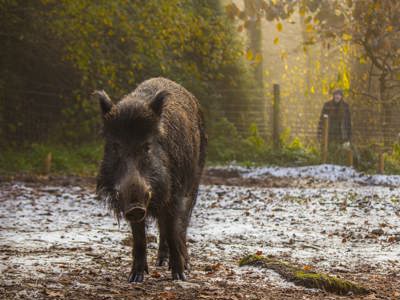
Wild Boar
Sus scrofa
Wild boar belong to the same family as our domesticated pigs, and consequently, look very similar. Males are normally larger and heavier than females (up to 30%). Wild boar have large heads, bulky muscular bodies with heavyset shoulders.
Both sexes have tusks; however, they are larger in males. Males also have a ridge of hair along their shoulders, which gives the appearance of a Mohican. Weights can be attributed to environmental factors, but males average 75-100kg and females 60-80kg.
Their coarse coat is made up of long bristles with an underlay of softer fur. Coat colour can range from very light brown to almost black. Boarlets are born with orange stripes, which gradually fade as they grow older.
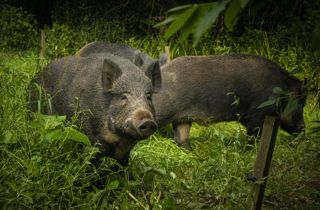
Wildwood's boars
We have three boars - Largatha, Gunnar and Ragnar. They spend a lot of their time asleep, so look for mounds of what appear to be earth - if it’s moving, it’s probably a boar! They love to roll around in different types of bedding, such as wood shavings and hay, and also like to carry around sticks.
Scroll down for more facts and insights into wild boar characteristics and behaviours.
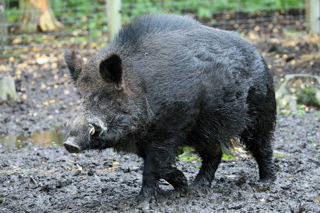
Behaviour
Boar live in social groupings of females, only joined by adult males during the breeding season (adult males outside of this time will remain solitary).
Wild boar are a keystone species: they help to support and maintain the ecosystem they live in as well as having a positive effect on many other organisms in the community. Wild boar feeding habits can be quite destructive; the use of their strong snouts and powerful neck muscles allow them to churn up large areas of soil in the search for food.
This activity creates new opportunities for birds and other animals by exposing invertebrates, as well as dispersing tree seeds and creating bare patches of soil for germination of other plants.
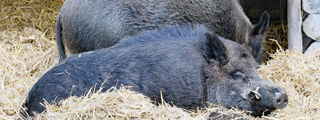
UK Status
Wild boar became extinct in the UK in the 13th century, due to hunting. A revival was attempted in the 1700’s but they struggled to re-establish due to further persecution. In the 20th century, wild boar were introduced as a livestock animal, farmed for their meat. However following escapes from both these farms and other captive populations, populations of wild boar seemed to re-establish themselves in the 1980s-1990s. To date, the largest population of wild boar in the UK in Kent/Sussex, is now thought to total around 1,000 animals. Gloucestershire is thought to be home to the second largest population in the Forest of Dean, and the smallest is thought to be in Dorset.
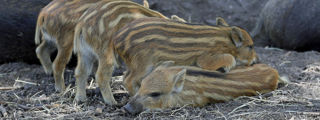
Threats
Wild boar have major threat globally. Localised threats do have impacts on local populations. Habitat destruction and hunting are the main contributors - both for food and sport as well as persecution of boar as agricultural pests.
Distribution
Wild boar has the widest distribution of any hoofed mammal in the world but this distribution has changed throughout history due to human pressures. The northern extent of its range stretched across from Scandinavia to Siberia, encompassing all of mainland Europe. Boar populations however had declined dramatically and in the UK had become extinct by the 14th century. Boar population recovery began in the 20th century.
Habitat
Boars favour deciduous and mixed forests, although being a generalist, wild boar can thrive in a variety of habitats including wetlands, shrub land, and coastal areas.
Diet
Boars have an opportunistic omnivorous diet (very similar to humans). Such a variable diet can be summarised into these four food categories: Rhizomes and roots; nuts, berries and seeds; Leaves and twigs; invertebrate and vertebrate prey.
Did you know?
A 50kg boar needs around 4,000-5,000 calories per day.

